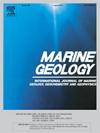A newly discovered submarine mud volcano in the southeastern continental shelf of Korea: Its evolution through mud volcanism, cold-water coral growth and bottom-current erosion
IF 2.6
3区 地球科学
Q2 GEOSCIENCES, MULTIDISCIPLINARY
引用次数: 0
Abstract
This study reports the first discovery of a mud volcano off southeastern Korea, based on multi-beam bathymetry, chirp seismic profiles, and sediment core analysis. The dimensions of the mound are comparable to mud volcanoes and mud cones previously identified on the Mediterranean Ridge and Gulf of Cádiz. A deep-rooted diapiric structure and lobate flow-like seafloor at the flanks also support that the mound formed by mud volcanism and mudflows. The mound crest is covered by dead cold-water corals, appearing as cone-shaped mound or rugged seafloor. The radiocarbon ages of coral fragments suggest that the mud volcano formed earlier than 7.1 ka; however, the timing and duration of coral habitation on the mound remain unknown. Currently, the morphology of the mound has been influenced by a strong bottom current, leading to the formation of a moat and drift system around the mound. The discovered mound is thus interpreted as a composite mud volcano that originated from mud volcanism and evolved via cold-water coral colonization and bottom-current erosion.
在韩国东南大陆架新发现的海底泥火山:泥火山作用、冷水珊瑚生长和底流侵蚀的演变
基于多波束测深、啁啾地震剖面和沉积物岩心分析,本研究报告了韩国东南部首次发现的泥火山。土丘的大小与先前在地中海山脊和Cádiz海湾发现的泥火山和泥锥相当。深根底辟构造和两侧的叶状流状海底也支持了泥火山作用和泥石流作用形成的土丘。丘顶被死亡的冷水珊瑚覆盖,呈锥形丘或崎岖的海底。珊瑚碎片放射性碳年龄表明泥火山形成时间早于7.1 ka;然而,珊瑚在丘上栖息的时间和持续时间仍然未知。目前,土墩的形态受到强烈的底流的影响,导致在土墩周围形成护城河和漂移系统。因此,发现的土丘被解释为一个复合泥火山,起源于泥火山作用,经过冷水珊瑚的殖民和底流侵蚀而演变。
本文章由计算机程序翻译,如有差异,请以英文原文为准。
求助全文
约1分钟内获得全文
求助全文
来源期刊

Marine Geology
地学-地球科学综合
CiteScore
6.10
自引率
6.90%
发文量
175
审稿时长
21.9 weeks
期刊介绍:
Marine Geology is the premier international journal on marine geological processes in the broadest sense. We seek papers that are comprehensive, interdisciplinary and synthetic that will be lasting contributions to the field. Although most papers are based on regional studies, they must demonstrate new findings of international significance. We accept papers on subjects as diverse as seafloor hydrothermal systems, beach dynamics, early diagenesis, microbiological studies in sediments, palaeoclimate studies and geophysical studies of the seabed. We encourage papers that address emerging new fields, for example the influence of anthropogenic processes on coastal/marine geology and coastal/marine geoarchaeology. We insist that the papers are concerned with the marine realm and that they deal with geology: with rocks, sediments, and physical and chemical processes affecting them. Papers should address scientific hypotheses: highly descriptive data compilations or papers that deal only with marine management and risk assessment should be submitted to other journals. Papers on laboratory or modelling studies must demonstrate direct relevance to marine processes or deposits. The primary criteria for acceptance of papers is that the science is of high quality, novel, significant, and of broad international interest.
 求助内容:
求助内容: 应助结果提醒方式:
应助结果提醒方式:


